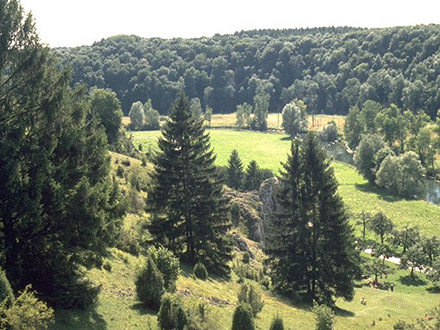Botanical name
Picea abies (L.) H. Karst.
Family
Pinaceae
Common name
Common spruce, Norway spruce, European spruce
Information about the plant
The spruce is predominant in the woodland cultivations of Northern and Central Europe. It grows very slowly when young but starts to grow strongly from the age of 20, reaching heights of 30 to 40 meters. The great uniformity of the tree taper makes it a popular ornamental tree. The name ‘Norway spruce’ derives from the red color of its bark; the bark of the ‘silver fir’ (Abies alba Mill.) is grey-white.
The needles of the spruce are 1.3 to 2.5 cm long, sharp and square, spiraling around the twig. The spruce blooms every three to four years, forming hanging cones 10 to 15 cm long, from which winged seeds fall the following spring. In autumn, the empty cones can be found under the tree.
Medicinally used parts of plants (herbal drug)
The fresh spruce tips (Piceae turiones) and the essential oil, spruce needle oil (Piceae aetheroleum), extracted from fresh, chopped branches and the attached needles by steam distillation, are used.
Constituents of the herbal drug
Fresh spruce tips contain essential oils and flavonoids. Spruce needle oil consists of monoterpenes, mainly bornyl acetate, pinene, phellandrene, and camphene.
Quality of the drug
There is no official quality specification for fresh spruce tips (Piceae turiones recentes). The quality of spruce needle oil (Piceae aetheroleum) is specified in the German Pharmacopoeia (DAB), which also states that spruce needle oil may be extracted from needles of the Siberian fir (Abies sibirica Ledeb.), as its essential oil closely resembles spruce needle oil.
Medical applications
Recognised medical use
Fresh spruce tips and spruce needle oil have not been evaluated by the HMPC or the ESCOP.
Traditional use
Fresh spruce tips and spruce needle oil have not yet been classified as traditional medicinal products (Article 16a of Directive 2001/83/EC).
Herbal drug preparations in finished dosage forms
- Aqueous extracts of fresh spruce tips for internal use
- Undiluted spruce needle oil for internal use
- Spruce needle oil in an alcoholic solution or incorporated in ointments, creams, emulsions, oils, and baths (e.g., for colds) for external use
Dosage
Finished medicinal product: see patient information leaflet.
Internally: Take 3 to 4 drops several times a day on a lump of sugar or in water.
Externally: For inhalation, add a few drops of spruce needle oil to hot water and inhale. Add 5 g of oil to a full bath (35 - 38°C) and soak for 10 to 20 minutes. Brew 200 to 300 g of fresh spruce tips with 1 liter of hot water, strain after 5 minutes, and pour the brew into a full bath.
Preparation of a tea
Not applicable.
Notes
In infants and toddlers up to 3 years of age, spruce needle oil can induce a glottis spasm (laryngospasm), potentially leading to respiratory arrest; therefore, never apply spruce needle oil to the face!
Do not use spruce needle oil for bronchial asthma or whooping cough and never near the eyes.
Do not use baths for major skin injuries, inflammatory skin diseases, fever, heart failure, or high blood pressure.
Side effects
Occasionally, skin irritations and eczema may occur.
Interactions
None known.
References
Herbal drug monographs
None available.
Further literature
Commentary on the German Pharmacopoeia (Spruce needle oil)


